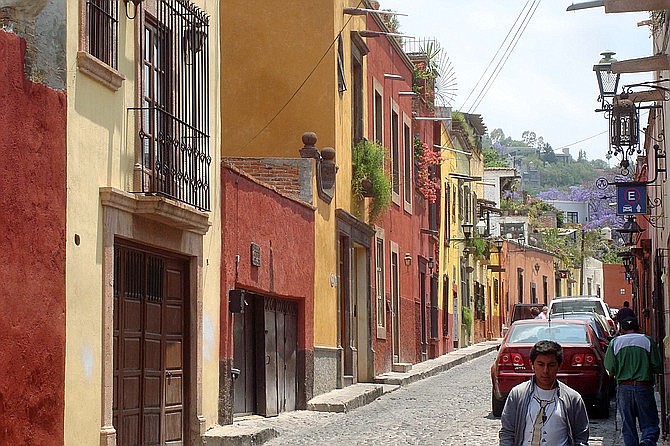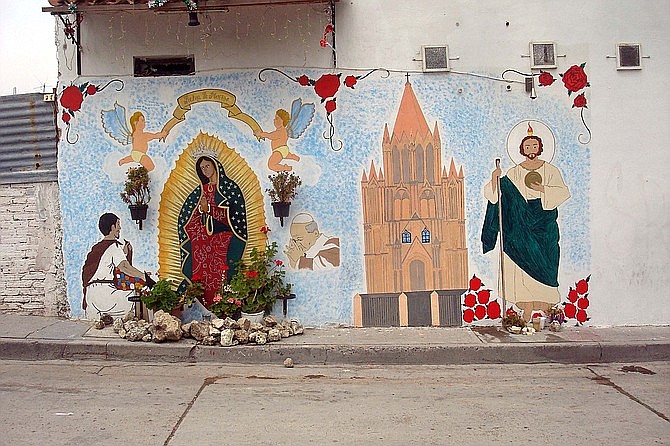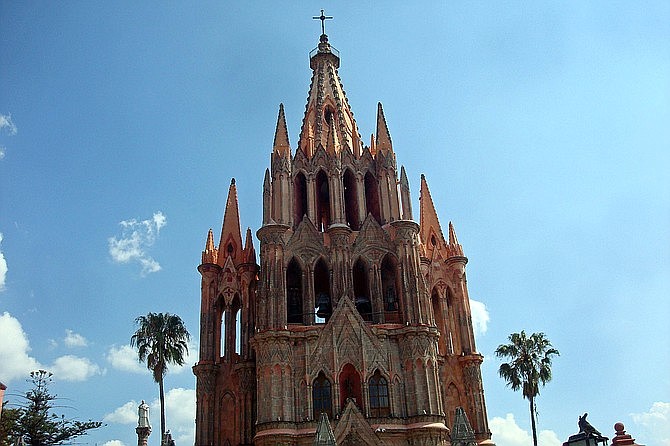 Facebook
Facebook
 X
X
 Instagram
Instagram
 TikTok
TikTok
 Youtube
Youtube

With no beach, no stoplights, and not even an airport, one might be surprised that San Miguel de Allende has been a magnet for Americans for decades. This strikingly beautiful and history-rich 16th- century town in the mountains of central Mexico got on the tourist and artist circuit soon after World War II as one of the few places outside of the U.S. where returning veterans could use their G.I. benefits to study art.

It flourished until during the “Red Scare.” Congress decided that Communists had infiltrated the teaching faculty, so it withdrew support from the veterans. But many Americans stayed and still more retired there. Later in the 1960s, the city developed a reputation as a haven from the social upheavals in the U.S., and beat writers and poets such as Jack Kerouac, Allen Ginsberg, William Burroughs and Ken Kesey, and a contingent of their followers, added to the ex-pat population.
The Americans were building on a far earlier historical infrastructure. Initially set-up as a garrison to protect internal roads the Spanish had built, it later became a key link on the silver route from mines in the north to Mexico City. With so much silver flowing through its streets, San Miguel developed an abundance of richly decorated churches and monuments. As early as 1926, it was named a national monument by Mexico and in 2008 as a UNESCO World Heritage Site, greatly contributing to its outstanding state of preservation.

San Miguel de Allende is known as the “City of Fallen Women,” and not because of the many bordellos that graced its streets during its silver days. Rather, it’s because of the large number of spills taken in trying to traverse its hills while treading on very irregular cobblestones. Go to any place where ex-pats congregate, and you are likely to see an assortment of casted limbs.
A map of the city does you little good for judging the time necessary to reach a destination, since what really matters is whether the route is uphill or downhill, as well as the size of the cobblestones that protrude along the route. But just as one develops skills in learning a great new path to avoid traffic, in San Miguel the focus is on finding an itinerary that avoids too many precipitous rises or falls.

Probably the most photographed place in town is the Parish Church, or La Parroquia. Although originally built with a typical Spanish colonial façade, in 1880 self-taught architect Gutierrez was called upon to correct some cracks in the foundation and walls. He convinced the powers that be to rebuild it with a Gothic façade for which he had gotten inspiration from postcards and etchings of European churches.
Today its two towers are a ready landmark which can be seen all over town and provide a beacon for those unsure of exactly where they are going.
Some people argue that SMA is now overrun with foreigners, and is only a Disneyland for tourists. Happily, we didn’t find that to be the case. Although it is estimated that about six to seven percent of its residents are ex-pats, we found that it was a rich cultural medley and blending of cultures, a peaceful coexistence rather than a sort of apartheid behind gated communities. And what was even more welcomed was the obvious contribution that the ex-pats were making to the health, education, and welfare of the locals. Everyone we met volunteers at least one day a week for some cause that serves to improve living standards. It might be leading walking tours of the city and handing over the proceeds to a program for health care, or it might be preparing meals to serve to local school children.
SMA is also an ideal place to improve your Spanish language skills. How many times I have tried my blighted Spanish in a foreign country, only to have the other person respond in English. Not so there, where all attempts are tolerated and there is the presumption that Spanish is the lingua franca. Of course, for the more diligent, language schools abound that can conveniently be supplemented by “person in the street” enhancement.
There is an abundance of things to do in this city which is pulsing with creativity, full of retired gringo writers, actors, artists, musicians, dancers and photographers. The complete list is in the weekly Atencion. We enjoyed everything from Woody Allen plays for $1.25 to fashionable art openings at Fabrica La Aurora.
While special events are always on-offer, there are things that visitors return to time and again. One favorite is a trip to La Gruta hot springs for a great breakfast, accompanied by fabulous local fruit juices, followed by a dip in their thermal waters. If you want to get more submerged in the healthful ambiance, go through the tunnel to the grotto where the mineral salts are stronger and there is even a waterfall to give you a natural massage. From there, you might want to move on to Galeria Atotonilco (reservations required), where some of the best handicrafts gathered throughout Mexico are on offer.
And then visit yet another UNESCO World Heritage site, the Sanctuario Atotonilco, for its fabulous frescoes of scenes from the Bible which has earned it the moniker of "Sistine Chapel of Mexico."

Back in town is another cultural highlight, a comprehensive collection of over 650 masks from all over Mexico, at the charming bed & breakfast Casa de la Cuesta, together with excellent video of the masks being used in dance.
But these are just a few examples of the wealth of attractions and activities in this small city. Equally important is budgeting time to simply experience the vibrancy of life, its sensory richness, as well as the serenity of the pace of activity. It is a life of simple priorities and charm, with just the right spice thrown in by the noise of firecrackers and the omnipresent ringing of bells.


With no beach, no stoplights, and not even an airport, one might be surprised that San Miguel de Allende has been a magnet for Americans for decades. This strikingly beautiful and history-rich 16th- century town in the mountains of central Mexico got on the tourist and artist circuit soon after World War II as one of the few places outside of the U.S. where returning veterans could use their G.I. benefits to study art.

It flourished until during the “Red Scare.” Congress decided that Communists had infiltrated the teaching faculty, so it withdrew support from the veterans. But many Americans stayed and still more retired there. Later in the 1960s, the city developed a reputation as a haven from the social upheavals in the U.S., and beat writers and poets such as Jack Kerouac, Allen Ginsberg, William Burroughs and Ken Kesey, and a contingent of their followers, added to the ex-pat population.
The Americans were building on a far earlier historical infrastructure. Initially set-up as a garrison to protect internal roads the Spanish had built, it later became a key link on the silver route from mines in the north to Mexico City. With so much silver flowing through its streets, San Miguel developed an abundance of richly decorated churches and monuments. As early as 1926, it was named a national monument by Mexico and in 2008 as a UNESCO World Heritage Site, greatly contributing to its outstanding state of preservation.

San Miguel de Allende is known as the “City of Fallen Women,” and not because of the many bordellos that graced its streets during its silver days. Rather, it’s because of the large number of spills taken in trying to traverse its hills while treading on very irregular cobblestones. Go to any place where ex-pats congregate, and you are likely to see an assortment of casted limbs.
A map of the city does you little good for judging the time necessary to reach a destination, since what really matters is whether the route is uphill or downhill, as well as the size of the cobblestones that protrude along the route. But just as one develops skills in learning a great new path to avoid traffic, in San Miguel the focus is on finding an itinerary that avoids too many precipitous rises or falls.

Probably the most photographed place in town is the Parish Church, or La Parroquia. Although originally built with a typical Spanish colonial façade, in 1880 self-taught architect Gutierrez was called upon to correct some cracks in the foundation and walls. He convinced the powers that be to rebuild it with a Gothic façade for which he had gotten inspiration from postcards and etchings of European churches.
Today its two towers are a ready landmark which can be seen all over town and provide a beacon for those unsure of exactly where they are going.
Some people argue that SMA is now overrun with foreigners, and is only a Disneyland for tourists. Happily, we didn’t find that to be the case. Although it is estimated that about six to seven percent of its residents are ex-pats, we found that it was a rich cultural medley and blending of cultures, a peaceful coexistence rather than a sort of apartheid behind gated communities. And what was even more welcomed was the obvious contribution that the ex-pats were making to the health, education, and welfare of the locals. Everyone we met volunteers at least one day a week for some cause that serves to improve living standards. It might be leading walking tours of the city and handing over the proceeds to a program for health care, or it might be preparing meals to serve to local school children.
SMA is also an ideal place to improve your Spanish language skills. How many times I have tried my blighted Spanish in a foreign country, only to have the other person respond in English. Not so there, where all attempts are tolerated and there is the presumption that Spanish is the lingua franca. Of course, for the more diligent, language schools abound that can conveniently be supplemented by “person in the street” enhancement.
There is an abundance of things to do in this city which is pulsing with creativity, full of retired gringo writers, actors, artists, musicians, dancers and photographers. The complete list is in the weekly Atencion. We enjoyed everything from Woody Allen plays for $1.25 to fashionable art openings at Fabrica La Aurora.
While special events are always on-offer, there are things that visitors return to time and again. One favorite is a trip to La Gruta hot springs for a great breakfast, accompanied by fabulous local fruit juices, followed by a dip in their thermal waters. If you want to get more submerged in the healthful ambiance, go through the tunnel to the grotto where the mineral salts are stronger and there is even a waterfall to give you a natural massage. From there, you might want to move on to Galeria Atotonilco (reservations required), where some of the best handicrafts gathered throughout Mexico are on offer.
And then visit yet another UNESCO World Heritage site, the Sanctuario Atotonilco, for its fabulous frescoes of scenes from the Bible which has earned it the moniker of "Sistine Chapel of Mexico."

Back in town is another cultural highlight, a comprehensive collection of over 650 masks from all over Mexico, at the charming bed & breakfast Casa de la Cuesta, together with excellent video of the masks being used in dance.
But these are just a few examples of the wealth of attractions and activities in this small city. Equally important is budgeting time to simply experience the vibrancy of life, its sensory richness, as well as the serenity of the pace of activity. It is a life of simple priorities and charm, with just the right spice thrown in by the noise of firecrackers and the omnipresent ringing of bells.
Comments